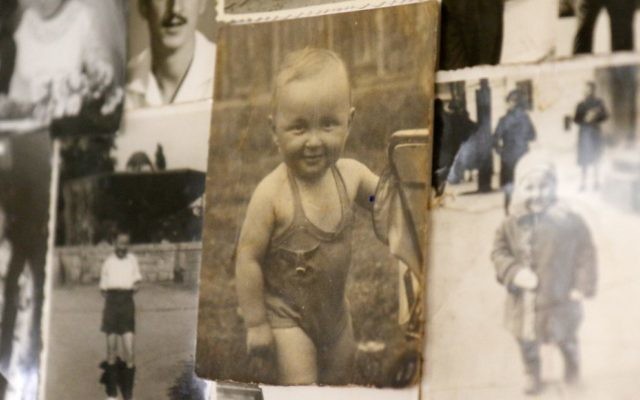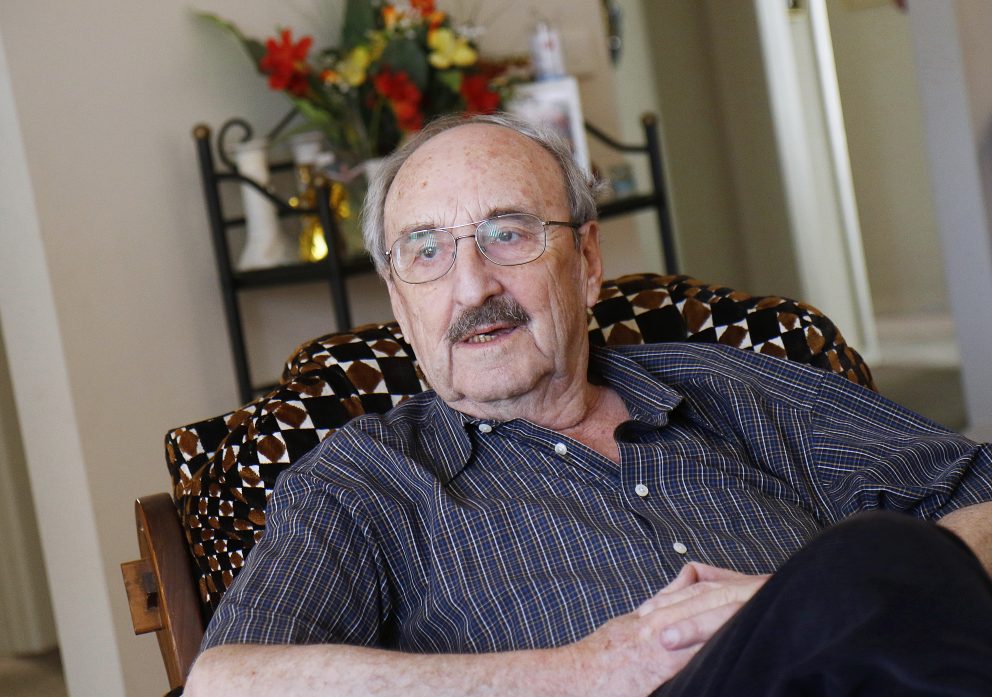Mordechai muses on Lodz
Mordechai Glasman is one of just a few child survivors of the Lodz Ghetto. He recently told his harrowing yet hopeful account at the 74th commemoration of the liquidation of Lodz Ghetto held at the Jewish Holocaust Centre. This is his story.
Mordechai Glasman is one of just a few child survivors of the Lodz Ghetto. He recently told his harrowing yet hopeful account at the 74th commemoration of the liquidation of the Lodz Ghetto held at the Jewish Holocaust Centre. This is his story.
MY name is Mordechai Glasman and I was born in the city of Lodz, Poland on July 4, 1937. This means when the war began in 1939, I was only two and a half years old.
When the Germans invaded Poland in World War II, the Nazis gave strict orders that all Jews in Lodz were to be rounded up and forced to live in a poor Lodz suburb, known as “Baluty”. This “Baluty quarter” soon became the “Lodz Ghetto” surrounded by barbed wire fencing and Nazi guards. For the next five years we would live inside this ghetto with no contact from the outside world. I remember my address in the ghetto – Number 6 Zydowska Street, Baluty.
The ghetto population had approximately 150,000 Jews from villages nearby, as well as a massive influx of Jews from Germany, Luxembourg and Czechoslavakia.
In the first two years, most people died from shortage of food, no housing and frostbite in the winter. I’ve been told approximately 70,000 died or half of the ghetto population perished this way.
As a boy aged five to seven, I remember to this day, seeing men, women and children lying dead in the streets. In fact, it was not unusual to be playing hide and seek with kids hiding under dead bodies. These corpses were eventually moved by horse driven wagon to the Jewish cemetery. The smell of dead bodies was unbearable.
At age five I was left alone at home by myself when my parents would go off to work in the ghetto.
I remember one morning staring out the window of our second floor apartment. Suddenly, I saw a woman, maybe 30 years old, jumping out the window from the third floor, plummeting to her death.
I was shocked, stunned and confused. I couldn’t understand the reason why this would happen.
When my parents returned home from work that evening, they explained to me that this women committed suicide. She found her child had died from starvation and she did not want to live.
This incident still gives me nightmares today.
Life in the ghetto got worse and worse each day. Every day, Nazi round-ups were made, herding Jews like cattle and sending them to concentration camps such as Chelmno and Auschwitz.
All this time inside the ghetto we had no idea of where our fellow Jews were going. We were isolated completely from the outside world.
There were also special roundups for children. Children under 10 years old were immediately sent to death camps thinking they were going to holiday camps. If you could not work, you were of no use to the Germans.
Children over 10 years old were sent to join the workforce inside the ghetto. Being 7 years old at this point, I was lucky that I was tall and thin. My parents somehow were able to bluff my age as being over 10.
So miraculously I was not sent to these death camps.
I found myself working as a message boy in a factory that made uniforms for the German army.
Another incident that stands out in my mind is when my father was summoned into the German Gestapo office, called the “krypo”. They demanded that he give them all his gold and jewellery or he will be beaten up. My father had no gold or jewellery. I remember him returning from the Gestapo office, beaten and bruised all over his body.
My father’s younger brother, uncle Heniek or Henry was in the Lodz Ghetto too. He worked as a “chef” in the Gestapo office under a chief Nazi officer who was called “Beibov”.
Working in the “krypo” was a big advantage for us. Uncle Heniek knew upfront when, and on which streets, round-ups were going to happen, so we could avoid getting caught by the Nazis who were systematically clearing out the ghetto to the camps.
In the last year, 1944, we all hid in an underground bunker built by my father, uncle and some other family which I cannot remember.
In total, there were approximately eight of us hiding in one little space or room. There was no light, no heating, no food, no nothing – just a tiny space to hide and hopefully escape being found.
Next to our bunker, maybe 100 metres away, was another bunker hiding about 24 people. Among these people was a well- known Jewish lawyer, Dr Wajskop.
At night time, my father, together with Dr Wajskop, would collect food scraps from the empty farms that were close by so we could eat. Raw potato was the main dish that we ate to keep going.
At one point, my mother had enough of hiding and she decided we should all leave the overcrowded bunker. We made our way to the other bunker to tell Dr Wajskop that we were leaving. Luckily, he had a receiver, also known today as a radio, and was able to tell us that millions of Jews were being killed every day and better we stay if we want to have a chance to survive.
One morning, we heard a lot of noises and screaming. We knew that the other bunker had been discovered by the Nazis. I was very worried that our bunker was next. I didn’t scream or make a noise, but I bit my nails through to their stubs in fear. My maturity stopped me from crying and being found.
Within moments, all the people in Dr Wajskop’s bunker were shot dead, except a father and his six-year-old daughter who managed to escape to the nearby thick forest. After some time they would somehow crawl into our bunker. When we heard them scratching above our bunker to let them in, I thought this was the end, so to find that it was only them was a major relief.
Dr Wajskop was a great man who stood up to the Krypo chief Beibov, even throwing a brick at him screaming, “We will not go to the slaughter like lambs!” He was shot on the spot – but forever remains my hero.
My parents were now scared and decided to leave the bunker and join a small work camp in the ghetto, “Jakuba 18”.
Our job would be to clear out any leftover furniture in the ghetto and send the pieces to Germany. The final task that we were given by the Nazis who were liquidating the ghetto was to dig holes in the Jewish cemetery – the soon-to-be graves for any remaining Jews still in the ghetto – including ourselves.
These holes or gravesites are still in the Lodz Cemetery today. They were never filled in, thank God.
I myself saw these holes with my own eyes when I visited Lodz a few years ago.
On January 17, 1945, the Russian army liberated our ghetto and we were set free.
From the 230,000 Jews who were in the Lodz Ghetto, only 588 survived.
As far as child survivors of the Lodz
Ghetto are concerned, you can count them on one hand. Actually, I read on the internet that just 12 children survived, so I guess that makes me 1 of 12.
After the war, we stayed in Lodz for another five years until I was 13 years old. While attending Polish high school, I was often bullied, told that my parents “killed Jesus” and subjected to antisemitic behaviour from Polish kids. Eventually, my parents moved me to a Jewish school for two years.
Amazingly, my parents managed to build a successful candle-making business, but under communism, private enterprise was condemned, so finally we were forced to flee for our lives from Poland. This time for good.
My mother, father and I grabbed what- ever we could in our hands. Suitcases in hand, we caught trains through Europe to Venice, Italy and arrived in Israel by boat in January, 1951.
I finished my schooling, joined the Israeli army for three years and graduated as an officer. I learnt Hebrew, my sixth language, before flying to Australia and landing at Essendon Airport to be with my Uncle Heniek and Aunty Bronia; and Uncle Bencion and Auntie Sala (all Auschwitz survivors) in March, 1963.
After two weeks in Australia, I met my beautiful wife Sara, whom I married one year later, and spent the next 55 years here raising a family together. We have three kids – Ilana, Simon and Sharon – and I now have eight gorgeous grandchildren, who are all here today!
Can you all please stand, I’m so proud of all of you.
Thank you for listening to my story.




comments